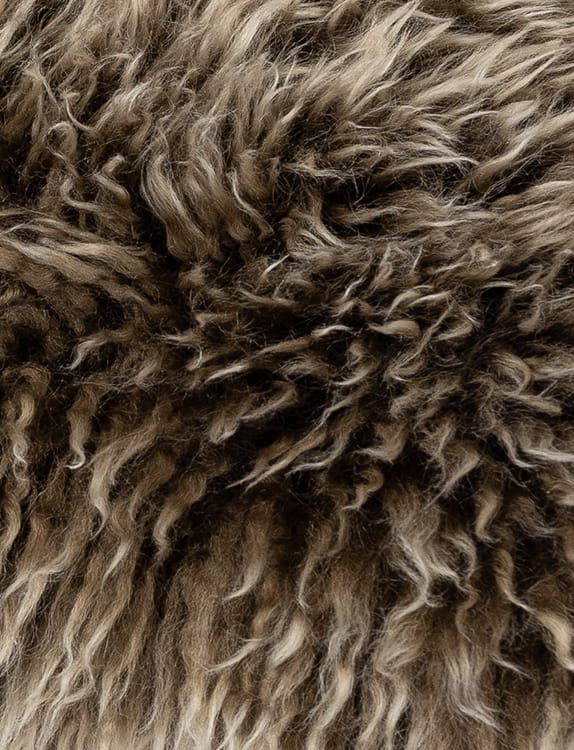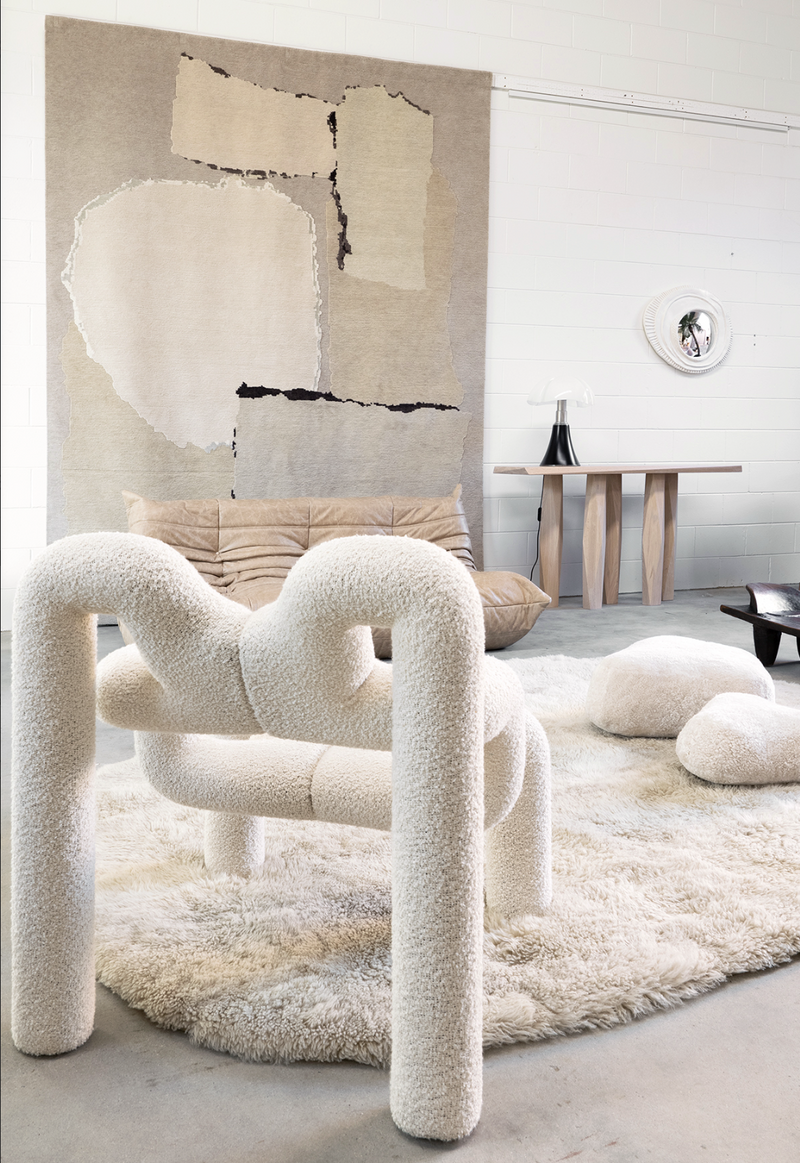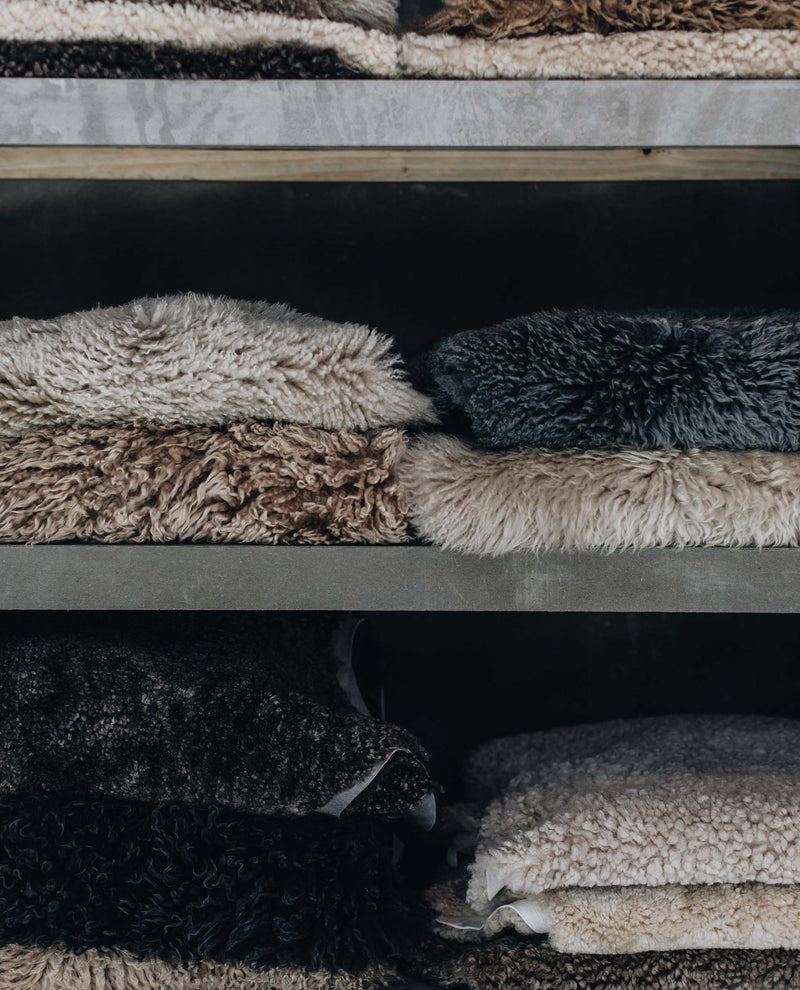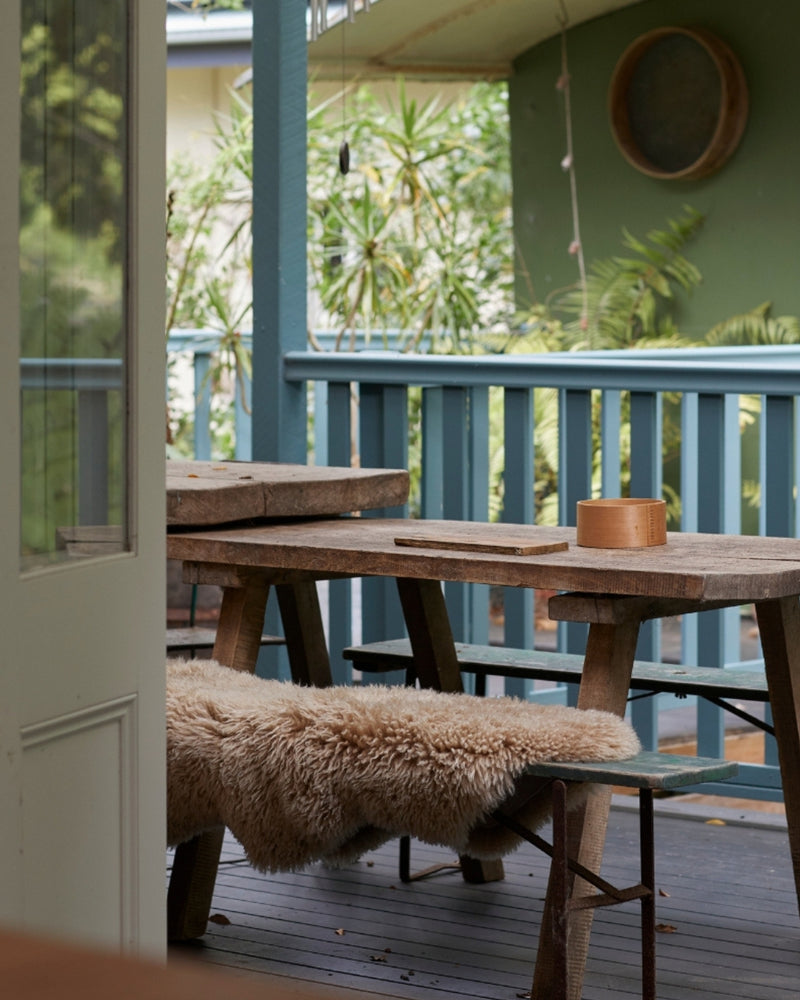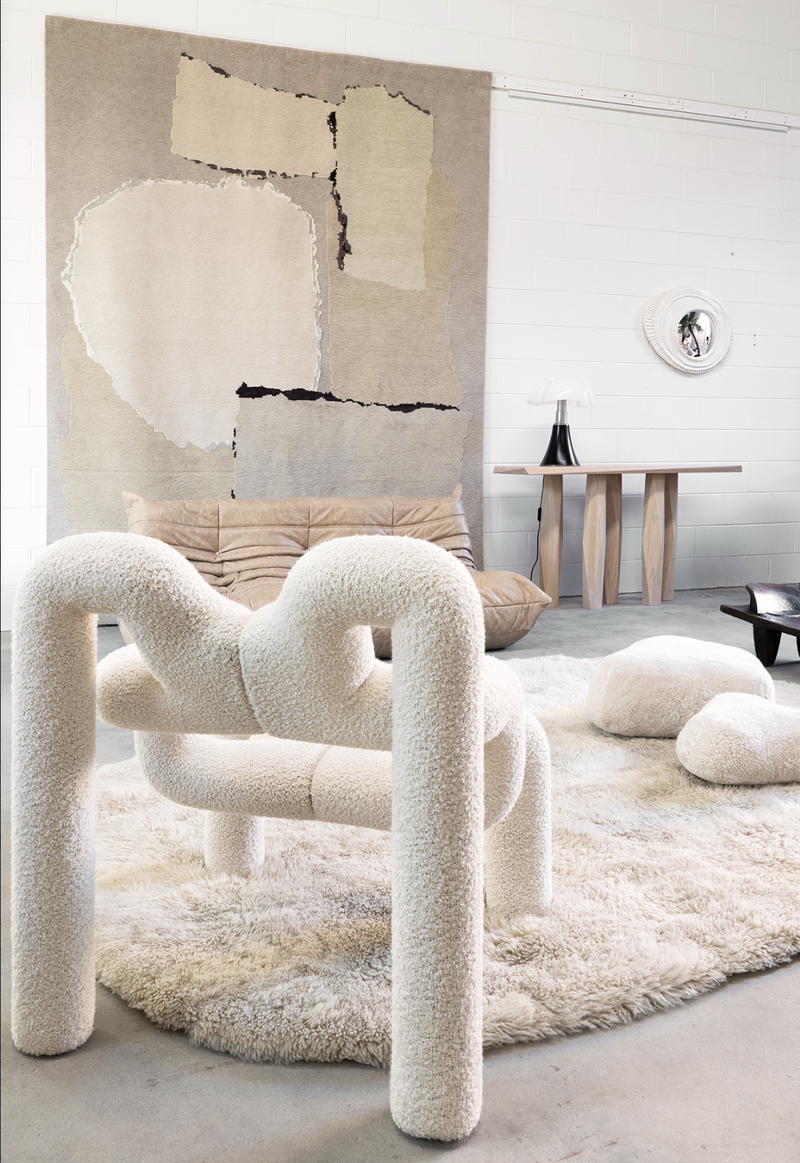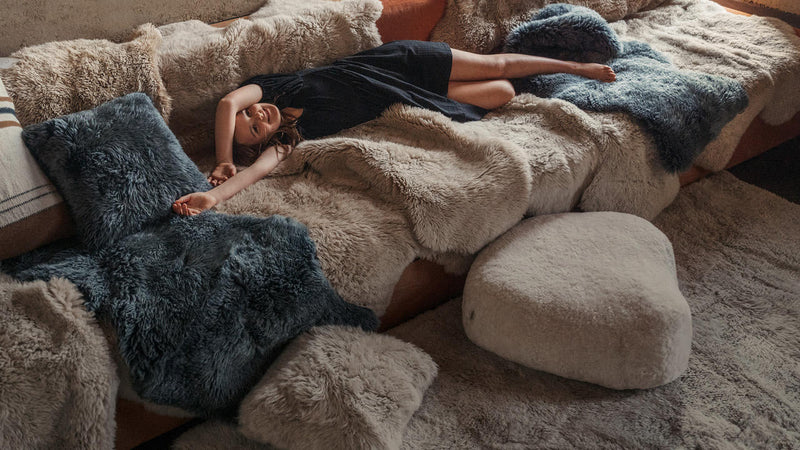care guide
General Sheepskin Care
One of the reasons we’re so passionate about replacing synthetics in the home with sheepskin is because it is easy to take care of and forgiving of life’s accidents and spills.
With a bit of basic care, your sheepskin product will look and feel good for a lifetime. Here are our top tips below:
The Five Golden Rules of Sheepskin Care
1. They love a good shake.
2. For larger items, like our Shaggy Bean Bags or Floor Rugs, a good vacuum every now and then will remove accumulated dirt or crumbs.
3. If you are keen to preserve the original colour of your sheepskin, avoid direct sunlight. Because it’s a natural fibre, prolonged exposure to sun will change the colour or give a fade on the area where the sunlight hits the sheepskin.
4. When you spill something on your sheepskin, act quickly. Take a read of our spot cleaning rules and remember, dab don’t rub.
5. If you’re unsure about a spill or stain, take it to a drycleaner with experience cleaning sheepskin.
Washing
In general, we do not wash our sheepskins. As long as we are regularly shaking, vacuuming and spot cleaning any mishaps, they shouldn’t require a full wash.
However, we do appreciate that washing can be a personal preference or, in some cases, is unavoidable. When our kids were young, there were a few exceptions where we washed our sheepskins. The upside is that the wool fibre side will love it, the down side is that the skin side will become a little stiffer.
So, should you decide you want to wash your sheepskin, you can put it on a cool delicate cycle, with low spin, using a mild wool detergent. Once the cycle has completed, give it a light stetch out while it’s wet to help retain its shape and reduce shrinkage. Drape it over a chair and let it dry naturally out of direct sunlight. Do not under any circumstances, tumble dry.
For larger items like The Shaggy Bean Bag or Floor Rug, we recommend using a professional dry cleaner who has experience cleaning sheepskin products.
Brushing
We find the best way to keep our sheepskin looking great is to run our fingers through the sheepskin fibre or give it a good vacuum. This keeps the natural curls intact.
While brushing can be nice for ‘straighter fibres’ we don’t recommend it for our natural curly sheepskins as, just like with human hair, it can make it look fluffy and frizzy.
If you do choose to give your sheepskin wool a brush, it’s best to use a wire comb brush (like a pet brush).
If you have regrets after brushing your sheepskin, you can lightly spritz the wool fibres with cool water and run your fingers through it to help revert the wool back to its original state.
Make sure you air dry it away from sunlight and direct heat.
Spot cleaning, specifical spills and stain removal
Our products are for real people and real life where things get spilled and accidents happen. Follow our steps below to get your sheepskin back to its best.
1. Act fast – the quicker you get on top of it, the less chance there is of it becoming a permanent feature. The first thing you want to do is remove as much of the spill as you can with something absorbent (we generally use paper towels) . You want to be dabbing and soaking the spill instead of rubbing it deeper into the sheepskin.
2. Once you have removed as much of the spill as you can, the next step is to dilute the stain with water. You can do this using a damp cloth or placing the affected area under running water but be careful to avoid the non-sheepskin parts of the products as this may cause damage, e.g. the suede backing. You can add a small amount of wool detergent if needed.
3. Once you have diluted the stain, you now need to absorb as much moisture as possible using a towel or something similar. The drier, the better.
4. Air dry flat, away from direct sunlight and heat.
Things not to do:
· Don’t use hot water when spot cleaning
· Don’t use bleach
· Don’t tumble dry
· Don’t iron
Tips for common stains and spills
Beer & Spirits: Dilute the spill area with cool water using a damp cloth. You can mix a small amount of wool detergent in with the cool water, OR use 1:1 white vinegar and water. Leave to dry naturally.
Blood: Dilute the spill area with cool water using a damp cloth. If the blood doesn’t come off with just water, mix a small amount of mild soap (wool detergent) with the water, using a cloth to dab the stain. Then use a clean damp cloth to rinse with cool water. Use a paper towel or dry cloth to dab up residual water. Leave to air dry.
Butter: Gently blot the butter with a clean, dry cloth or paper towel to soak up as much as possible. Sprinkle a small amount of cornstarch, talcum powder, or baby powder directly onto the butter stain. Let it sit for 15-20 minutes to absorb the grease. Then, gently brush it off with a soft brush or cloth. If the butter looks to have stained, mix a small amount of wool wash with the water, using a cloth to blot the stain. Then use a clean damp cloth to ‘rinse’ with cool water. Use a paper towel or dry cloth to dab up residual water. Leave to air dry.
Chewing gum: Wrap some ice cubes in a plastic bag or cloth and gently press it onto the gum. Once the gum is hardened, use a plastic knife, spoon, or blunt object to carefully scrape the gum off the sheepskin. Be gentle to avoid damaging the wool. If there’s any leftover residue, you can apply a small amount of rubbing alcohol or vinegar on a soft cloth and gently blot the area.
Chocolate: Gently scrape off any excess chocolate using a blunt knife or spoon. Create a mild soap solution by mixing a small amount of wool-wash with cold water. Use a soft cloth to dab the stained area gently. Then use a clean damp cloth to rinse with cool water. Use a paper towel or dry cloth to dab up residual water. Leave to air dry.
Cola or soft drinks: Dilute the spill area with cool water using a damp cloth. You can mix in a small amount of wool detergent OR use 1:1 white vinegar and water. If it’s still dark, you can let it sit for a couple of minutes before dabbing again with a clean damp cloth to remove residue. Dab with a paper towel or dry cloth to soak up the moisture. Leave to air dry.
Cooking oil: Gently dab the oil with a clean, dry cloth or paper towel to soak up as much as possible. Sprinkle a small amount of cornstarch, talcum powder, or baby powder directly onto the oil stain. Let it sit for 15-20 minutes to absorb the grease. Then, gently brush it off with a soft brush or cloth. If the oil looks to have stained, mix a small amount of wool wash with the water, using a cloth to dab the stain. Then use aclean damp cloth to rinse with cool water. Use a paper towel or dry cloth to dab up residual water. Leave to air dry.
Faeces: Use a plastic spatula, spoon, or blunt knife to gently scrape off as much of the faeces as possible. Create a mild soap solution by mixing a small amount of wool wash with cold water. Use a soft cloth to blot the stained area gently. Then use a clean damp cloth to rinse with cool water. Use a paper towel or dry cloth to blot up residual water. Leave to air dry.
Juice: Dilute the spill area with cool water using a damp cloth. You can mix a small amount of wool detergent in with the cool water, OR use 1:1 white vinegar to water. Dab again with a clean damp cloth to remove residue, then dab with a paper towel or dry cloth to soak up the moisture. Leave to air dry.
Milk: dilute the spill area with cool water using a damp cloth. Mix a small amount of wool wash with the water, using a cloth to dab the stain. Then use a clean damp cloth to rinse with cool water. Use a paper towel or dry cloth to dab up residual water. Leave to air dry.
Mud: if still wet, carefully scrape off as much as possible. Option 1: Leave to dry, then give a little finger brush to separate, and vacuum. Option 2: use a clean damp cloth to rinse the area with cool water. Use a paper towel or dry cloth to dab up residual water. Leave to air dry.
Nail Polish: Use acetone-free nail polish remover. Test a small area first: nail polish remover can be harsh, so test it on an inconspicuous area of the sheepskin first to ensure it won’t discolour.
Oil & grease: Gently dab the oil/grease with a clean, dry cloth or paper towel to soak up as much as possible. Sprinkle a small amount of cornstarch, talcum powder, or baby powder directly onto the oil/grease stain. Let it sit for 15-20 minutes to absorb the oil/grease. Then, gently brush it off with a soft brush or cloth. If it looks to have stained, mix a small amount of wool wash with water, using a cloth to dab the stain. Then use a clean damp cloth to rinse with cool water. Use a paper towel or dry cloth to dab up residual water. Leave to air dry.
Paint (oil based): Gently scrape off any excess paint with a blunt object like a spoon or a plastic spatula. Using a citrus paint remover (you can very carefully use turpentine or mineral spirits if you only have them but it is best to test in an inconspicuous area first) dampen a soft cloth or cotton ball with the solvent and gently blot the paint stain. After the paint is removed mix a small amount of mild soap wool wash with water, using a cloth to blot the stain. Then use a clean damp cloth to rinse with cool water. Use a paper towel or dry cloth to dab up residual water. Leave to air dry.
Paint (acrylic): Dilute the spill area with cool water using a damp cloth. If the paint doesn’t come off with just water, mix a small amount of wool wash with the water, using a cloth to blot the stain. Then use a clean damp cloth to rinse with cool water. Use a paper towel or dry cloth to dab up residual water. Leave to air dry.
Red wine: Dilute the spill area with cool water using a wet cloth. You can mix in a small amount of wool detergent in with the cool water, then blot with a clean damp cloth to remove residue and excess moisture – repeat as many times as needed. Blot with a paper towel or dry cloth to soak up the moisture. Leave to air dry.
Soot: Take the sheepskin outside and shake it gently to remove loose soot particles. Avoid rubbing, as this can push the soot deeper into the fibres. Carefully vacuum the area in a dabbing up-down motion. For any residual soot, mix a small amount of wool wash with water, using a cloth to blot the stain. Then use a clean damp cloth to rinse with cool water. Use a paper towel or dry cloth to blot up residual water. Leave to air dry.
Tar: Wrap some ice cubes in a plastic bag or cloth and gently press it onto the tar. Once the tar is hardened, use a plastic knife, spoon, or blunt object to carefully scrape the tar off the sheepskin. Be gentle to avoid damaging the wool. Dampen a cloth with coconut oil, olive oil, eucalyptus oil, or lanolin-based leather conditioner and gently dab the tar. Let it sit for 5 mins to loosen the tar, then wipe away with a paper towel or clean cloth. Mix a small amount of wool wash with water, using a cloth to blot the stain. Then use a clean damp cloth to rinse with cool water. Use a paper towel or dry cloth to dab up residual water. Leave to air dry.
Tea: Dilute the spill area with cool water using a damp cloth. You can mix in a small amount of wool detergent in with the cool water. Dab with a clean damp cloth to remove residue and excess moisture – repeat as many times as needed. Then dab with a paper towel or dry cloth to soak up the moisture. Leave to air dry.
Tomato sauce: Gently scrape off any excess sauce using a blunt knife or spoon. Dilute the spill area with cool water using a damp cloth. Use 1:1 white vinegar with cool water. If it’s dry or partially dry, you can let it sit for a couple of minutes before blotting again with a clean damp cloth to remove residue, then blot with a paper towel or dry cloth to soak up the moisture. Repeat if needed. Leave to air dry.
Urine (old): Lightly dampen the stained area with a 1:1 vinegar to water mixture and let soak for 5 mins. Blot with a clean damp cloth. Sprinkle baking soda over the damp area to absorb remaining moisture and neutralize odours. Let the baking soda sit overnight, then shake or vacuum it off. Repeat if needed. Alternatively, seek an experienced dry cleaner.
Urine (fresh): Dilute the spill area with cool water using a damp cloth. You can mix a small amount of wool detergent in with the cool water OR use 1:1 white vinegar with cool water. Dab with a clean damp cloth to remove residue, then dab with a paper towel or dry cloth to soak up the moisture. Leave to air dry.
Vomit: Use a plastic spatula, spoon, or blunt knife to gently scrape off as much of the vomit as possible. Create a mild soap solution by mixing a small amount of wool wash with cold water. Use a soft cloth to blot the spill area gently. Then use a clean damp cloth to rinse with cool water. Use a paper towel or dry cloth to dab up residual water. Leave to air dry.

